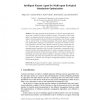Free Online Productivity Tools
i2Speak
i2Symbol
i2OCR
iTex2Img
iWeb2Print
iWeb2Shot
i2Type
iPdf2Split
iPdf2Merge
i2Bopomofo
i2Arabic
i2Style
i2Image
i2PDF
iLatex2Rtf
Sci2ools
EPIA
2007
Springer
2007
Springer
Intelligent Farmer Agent for Multi-agent Ecological Simulations Optimization
Abstract. This paper presents the development of a bivalve farmer agent interacting with a realistic ecological simulation system. The purpose of the farmer agent is to determine the best combinations of bivalve seeding areas in a large region, maximizing the production without exceeding the total allowed seeding area. A system based on simulated annealing, tabu search, genetic algorithms and reinforcement learning, was developed to minimize the number of iterations required to unravel a semi-optimum solution by using customizable tactics. The farmer agent is part of a multi-agent system where several agents, representing human interaction with the coastal ecosystems, communicate with a realistic simulator developed especially for aquatic ecological simulations. The experiments performed revealed promising results in the field of optimization techniques and multi-agent systems applied to ecological simulations. The results obtained open many other possible uses of the simulation archit...
| Added | 07 Jun 2010 |
| Updated | 07 Jun 2010 |
| Type | Conference |
| Year | 2007 |
| Where | EPIA |
| Authors | Filipe Cruz, António Pereira, Pedro Valente, Pedro Duarte, Luís Paulo Reis |
Comments (0)

